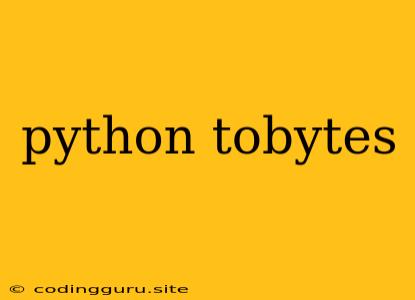Understanding the tobytes() Method in Python
In Python, the tobytes() method plays a crucial role in converting various data types into a byte sequence, essential for tasks like network communication, file handling, and data serialization. This method is particularly useful when working with memory-efficient data structures or when you need to interact with systems expecting data in a specific binary format.
Why Use tobytes()?
Imagine you have a string, a list, or a NumPy array that you need to send over a network socket. The data needs to be transmitted as a sequence of bytes. That's where tobytes() comes in. It allows you to convert your data into a byte sequence, ensuring compatibility with the target system.
How Does tobytes() Work?
The tobytes() method is typically associated with data structures that hold information as sequences of bytes, such as:
- Bytes objects: These objects are already in byte form, so
tobytes()simply returns a copy of the existing bytes. - Bytearray objects: Similar to bytes objects,
tobytes()returns a copy of the underlying byte sequence. - Arrays: NumPy arrays provide the
tobytes()method to convert the array's contents into a contiguous block of bytes. - MemoryViews:
memoryviewobjects offer a way to access data without copying it, enabling you to work directly with byte sequences in memory.
Common Use Cases of tobytes():
- Network Communication: When sending data across a network, such as through a socket, it's essential to represent the data as a byte sequence. The
tobytes()method allows you to convert your data into a format suitable for network transmission. - File Handling: Writing binary data to files often requires converting data into byte sequences.
tobytes()helps you convert data structures into the appropriate format for binary file operations. - Serialization: The process of converting data into a format suitable for storage or transmission is known as serialization.
tobytes()aids in converting Python data structures into a byte sequence for serialization. - Interfacing with C Libraries: Many C libraries expect data in specific binary formats.
tobytes()enables you to bridge the gap between Python and C by converting data to the necessary byte sequence.
Simple Examples:
# Example 1: Converting a string to bytes
my_string = "Hello, world!"
byte_sequence = my_string.encode('utf-8')
print(byte_sequence)
# Example 2: Converting a NumPy array to bytes
import numpy as np
my_array = np.array([1, 2, 3, 4, 5])
byte_sequence = my_array.tobytes()
print(byte_sequence)
# Example 3: Converting a bytearray to bytes
my_bytearray = bytearray([1, 2, 3, 4, 5])
byte_sequence = my_bytearray.tobytes()
print(byte_sequence)
Key Points to Remember:
- Encoding: When working with strings, remember to specify the encoding scheme, such as
utf-8, to ensure correct conversion. - Endianness: If you're dealing with binary data formats that are sensitive to endianness (the order of bytes), make sure you understand and handle it appropriately.
Conclusion
The tobytes() method empowers you to transform Python data structures into byte sequences, making it an invaluable tool for various programming scenarios. By understanding its functionalities and using it correctly, you can effectively handle binary data, facilitating tasks like network communication, file handling, and data serialization.
